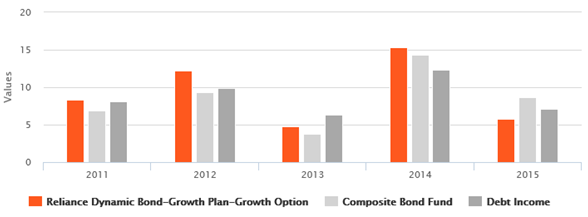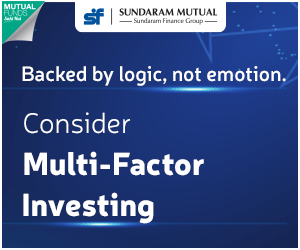Reliance Dynamic Bond Fund: One of the most consistent income funds

For debt mutual fund investors with a long term investment horizon, dynamic bond funds are good investment options. While these funds are subject to interest rate risk, over a 3 year investment horizon these funds can give excellent returns. In fact, if you look up the top 10 income funds in terms of 3 year trailing returns, you will observe that the majority of them are dynamic bond funds.
What are dynamic bond funds?
Dynamic bond funds like many other income funds invest in a portfolio of government and corporate bonds. However, unlike other income funds, in dynamic bond funds, the fund manager has the flexibility to actively manage the duration of his or her portfolio, depending on the fund manager’s outlook on interest rates. Bond prices rise when interest rates fall and fall when interest rate rises. Long duration bonds are more sensitive to interest rate movements compared to short duration bonds. If the fund manager believes that interest rates will fall in the future then he or she will invest in long duration bonds to take advantage of price appreciation of the bonds. If the fund manager expects interest rates to rise, then he or she will invest in short duration bonds, which will limit interest rate risk. Therefore, dynamic bond funds can give good returns in a lower interest environment, while limiting downside during periods of rising interest rates. As such these funds are ideal long term debt investments for retail investors who want to profit from interest rate movements but are unclear about the trajectory and timing of the movements. You can rely on the expertise of the fund manager to make the right call. While the Government has stuck to FY 2017 fiscal deficit target in the Budget creating room for the Reserve Bank of India to cut the repo rate in the coming weeks, the magnitude of rate cuts in the coming fiscal year will depend on a number of unknowns. As such the outlook is a little hazy because global macro-economic uncertainties persist and there is the risk of uptick in food inflation if monsoons disappoint again. In such a situation, dynamic bond funds are good investment options for long term debt fund investors.
Reliance Dynamic Bond Fund
We believe that consistency of performance should be an important consideration when selecting a dynamic bond fund. Consistency of performance shows the dynamic bond fund manager’s ability to manage the portfolio duration, and therefore returns, in different interest rate scenarios. Reliance Dynamic Bond Fund has been ranked as very strong consistent performer among all income funds by CRISIL (Rank 1 among income consistent performers in the quarter ended December 31, 2015). Morningstar also rates this fund highly with a 4 star rating. The 3 year rolling returns chart over the last 5 years shows why this fund is rated as a top consistent performer. The orange line shows the three year rolling returns of Reliance Dynamic Bond Fund and the black line shows the three year rolling returns of the benchmark index, CRISIL Composite Bond Index.

Source: Advisorkhoj Research
You can see that Reliance Dynamic Bond Fund has beaten the benchmark index almost 90% of the times in terms of 3 year rolling returns over the past 5 years. Further observe that the 3 year rolling returns have been above 30% (more than 10% annual) almost 70% of the times, irrespective of when you invested in the last 5 years. Bond yields had hardened a bit from October 2015 to March 2016. Therefore, you can see a decline in the rolling returns towards the end. But Reliance Dynamic Bond Fund is expected to benefit from the widely anticipated rate cut by the RBI in the first week of April. In fact, yields have been softening through the month of March and in the last one month, though not apparent in the chart above, Reliance Dynamic Bond Fund has given nearly 1% returns (based on March 24 2016 NAVs).
There is a perception among many retail investors that all income funds are risky. The notion of risk among retail investors is very subjective, often based on what others are saying or by their own biases and not informed by actual data. The lowest 3 year return of Reliance Dynamic Bond fund at any point of time in the last 5 years, which included various interest rate scenarios, is around 23%. This means that the lowest possible compounded annual return you would have got from Reliance Dynamic Bond Fund, at any point of time in the last 5 years is around 7%. Compare this with fixed deposit interest of 9%. If you are an investor in the highest tax bracket, your effective post tax return from 9% fixed deposit will be around 6.2%. Debt mutual funds held for over 3 years are taxed at 20% with indexation benefits. Factoring in indexation benefits, the lowest post tax 3 year annualized returns of Reliance Dynamic Bond fund in the last 5 years would be 6.7%, which is still higher than the post tax fixed deposit return. Of course, it must be mentioned that fixed deposits and debt mutual funds are not comparable. Fixed deposits assure guaranteed returns, whereas mutual funds are subject to market risks and cannot assure returns.
However, if you understand the risk return characteristics of income funds, especially dynamic bond funds, they make compelling investment choices for long term debt investors. Investors should understand that, while dynamic bond funds are subject to interest rate risks, if investors have a sufficiently long investment horizon, encompassing interest rate cycles, there will be periods when these funds will underperform versus fixed deposits and other assured return products, but there will also be periods when these funds will outperform assured return products. Over a three year or more investment horizon, irrespective of interest rate scenarios, given the fact that dynamic bond funds are actively managed and that they enjoy tax benefits, these funds can be expected to deliver superior returns.
Reliance Dynamic Bond fund was launched in November 2004 and has over र 5,400 crores of assets under management. The expense ratio of the fund is 1.67%. Prashant Rimple is the fund manager of Reliance Dynamic Bond Fund. The fund has delivered more than 8% annual returns in three out of the last five years, and in two out of those three years, the fund delivered more than 12% annual returns. The fund has also outperformed the income fund category in most years (please see the chart below).

Source: Advisorkhoj Research
The chart below shows the growth of र 100,000 lump sum investment in Reliance Dynamic Bond Fund over the last 5 years.

Source: Advisorkhoj Research
In the last 5 years you could have made a profit of र 57,000 on an investment of र 100,000. The annualized returns would be 9.5%.
Portfolio Construction of Reliance Dynamic Bond Fund
We had discussed earlier that fund managers of Dynamic Bond Funds actively manage the portfolio maturity and duration, depending on their outlook on interest rates and bond yields. Therefore the portfolio construction can change a lot from time to time, depending on the strategy of the fund manager. Currently, 90% of the portfolio of Reliance Dynamic Bond Fund is invested in Government Securities, about 7% in Corporate Bonds and 3% in money market instruments. The average maturity of the portfolio is 14 years. It is clear from this portfolio construction that the fund manager is expecting interest rates and bond yields to decline. The yield to maturity of the portfolio is 8.2% and the modified duration of the portfolio is 7 years. Yield to maturity is the annual returns the fund will get by holding the bonds in its portfolio to maturity. Modified duration is the change in bond price for a 1% change in interest rate or yield. Therefore, if interest rates go down by 50 bps this coming fiscal year, the price of the bonds in the portfolio of Reliance Dynamic Bond Fund will increase by 3.5%. This price appreciation is over and above what the fund will earn in terms of yields from their bonds during the year. Therefore, in very simple terms, if interest rates go down by 0.5%, the fund can give 11.7% returns (8.2% + 3.5%) before expenses. Even after deducting expenses (expense ratio of 1.67%), the fund can give double digit returns if interest rates decline by 0.5%. This analysis is purely illustrative to show you how the concepts of yield to maturity and modified duration work. The actual returns of the fund will depend on a variety of factors. Reduction in repo rates may or may not result in a reduction of interest rates by the same amount. In fact, bond yields have softened a bit already in anticipation of the rate cut. There are a number of macro-economic risk factors, both local and global. The portfolio construction itself can change during the year and that will have an impact on returns.
About 6% of the fund portfolio is currently invested in corporate bonds. Since the percentage is small, the effect of interest rate and credit easing may not have a big impact on the final returns of the fund. For the benefit of our readers, interest rate reduction and overall credit conditions in the economy have a dual impact on corporate bonds. We had discussed earlier that bond prices go up when interest rates decline and vice versa. Therefore interest rate decline will have a positive effect on corporate bond prices. Further, with credit easing in the economy, for which the RBI and the banking system are taking steps, lower rated bonds can get upgraded to higher ratings, e.g. A to AA, AA to AAA etc. As discussed earlier, potential corporate bond ratings upgrade will have a limited impact on the performance of Reliance Dynamic Bond Fund, but nevertheless it will have an impact, even though limited.
Conclusion
The consistent performance of Reliance Dynamic Bond Fund makes it a good investment option for long term debt investors. To take full advantage of interest rate cycle, investors should have at least a 2 to 3 year horizon for investing in the fund. A three year or more investment tenure is ideal because investors can avail of the tax benefits given to debt mutual funds. Investors should consult with their financial advisors if Reliance Dynamic Bond Fund is suitable for their financial needs.
Queries
-
What is the benefit of mutual fund STP
Aug 29, 2019
-
How much to invest to meet target amount of Rs 2 Crores
Aug 26, 2019
-
Can I achieve my financial goals with my current mutual fund investments
Aug 24, 2019
-
Can you tell me return of various indices
Aug 19, 2019
-
What would be the post tax return on different investments
Aug 18, 2019
-
Which Principal Mutual Fund scheme will be suitable for my retirement corpus
Aug 16, 2019
-
What is the minimum holding period for availing NCD interest
Aug 4, 2019
Top Performing Mutual Funds
Recommended Reading
Fund News
-
Axis Mutual Fund launches Axis Gold and Silver Passive FOF
Dec 10, 2025 by Advisorkhoj Team
-
Jio BlackRock Mutual Fund launches JioBlackRock Arbitrage Fund
Dec 9, 2025 by Advisorkhoj Team
-
Tata Mutual Fund launches Tata BSE Multicap Consumption 50:30:20 Index Fund
Dec 9, 2025 by Advisorkhoj Team
-
Edelweiss Mutual Fund launches Edelweiss Silver ETF Fund of Fund
Dec 8, 2025 by Advisorkhoj Team
-
Abakkus Mutual Fund launches Abakkus Liquid Fund
Dec 8, 2025 by Advisorkhoj Team














